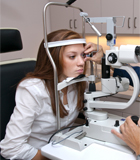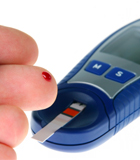Diabetic Eye Conditions
 What are Diabetic Eye Conditions?
What are Diabetic Eye Conditions?
Patients with diabetes are at an increased risk of developing eye diseases that can lead to vision loss and blindness, such as diabetic retinopathy, cataracts and glaucoma. In fact, diabetes is actually the leading cause of blindness in the United States.
Diabetic eye conditions often develop without any noticeable vision loss or pain, so significant damage may already be done to the eye by the time patients notice any symptoms. For this reason, it is important for diabetic patients to have their eyes examined at least once a year. Early detection of eye disease can help prevent permanent damage.
Diabetic-related eye problems develop from high blood sugar levels, which can cause damage to blood vessels in the eye. Over 40 percent of diabetic patients will develop some form of eye disease in their life. The risk of developing eye problems can be reduced through regular eye exams and by keeping blood sugar levels under control through a healthy diet and regular exercise.
Cause of Diabetic Eye Conditions
Diabetic eye conditions develop in the retina as a result of microvascular abnormalities. The tiny blood vessels within the retina develop microaneurysms and begin to leak blood. As new blood vessels develop, they also leak blood and can cause hemorrhages and permanent damage to the retina.
While diabetics struggle with a high sugar count in the blood along with insufficient insulin production, it is actually the lack of oxygen in the blood that causes eye problems and leads to vision loss.
Patient Testimonial
"The staff were very friendly, helpful. They were able to get me in the same day. Dr.Guillory engages the clinical concerns with ease, clearly explains. I felt heard and my needs were effectively addressed that day. I will definitely return to this location."
How are Diabetic Eye Conditions Diagnosed?

Eye exams should be performed at least once a year or as soon as any potential problems are detected in order to ensure early detection of any serious conditions. Early detection is the strongest protection against diabetic eye diseases.
Diabetic Retinopathy
Diabetic retinopathy is the most common type of diabetic eye disease and the leading cause of blindness in the US. This condition is caused by blood vessel changes within the retina that lead to swelling and leaking of fluid. It can also cause growth of abnormal new blood vessels on the surface of the retina. There are four stages of diabetic retinopathy that begin with the occurrence of microaneurysms and eventually lead to abnormal blood vessels on the surface of the retina that can easily leak fluid and cause severe vision loss and even blindness.
The fluid can also leak into the center of the macula and cause swelling and blurred vision, a condition known as macular edema. The risk of developing macular edema increases as diabetic retinopathy progresses.
Treatment of Diabetic Eye Conditions
Treatment for early stages of diabetic retinopathy and other conditions starts with maintaining levels of blood sugar, blood pressure and blood cholesterol, in order to prevent any permanent damage from occurring. For more advanced stages of the condition a laser, in office injection, or outpatient surgery may be required.
Macular edema can be treated through a laser procedure, called focal laser or with newly developed medications that can be injected in the clinic.
Laser treatments and injections can be performed in your doctor's office and are performed with anesthetic eye drops to minimize pain.


 What are Diabetic Eye Conditions?
What are Diabetic Eye Conditions?